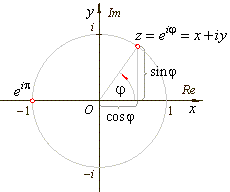|
|
|
|
Imaginary
and complex numbers |
 Exponentiation
and root extraction of complex numbers in the polar form
Exponentiation
and root extraction of complex numbers in the polar form |
|
Powers and roots of
complex numbers, use of de Moivre’s formulas examples |
 Euler’s
formula,
relationship between trigonometric functions and the complex exponential
function
Euler’s
formula,
relationship between trigonometric functions and the complex exponential
function |
|
|
|
|
|
|
| Exponentiation
and root extraction of complex numbers in the polar form - de
Moivre's formula |
| We use the polar form
for exponentiation and root extraction of complex numbers that
are known as de Moivre's formulas. |
| |
zn
= rn · [cos(nj)
+ isin(nj)] |
|
|
| and |
 |
|
|
|
| Powers and roots of
complex numbers, use of de Moivre’s formulas examples |
| Example: |
Compute |
 |
|
|
| Solution: |
 |
|
| or
in the polar form, |
 |
|
| and |
 |
|
| since
exponentiation with integer exponent |
 |
|
| then |
 |
|
|
| Example: |
Compute |
 |
|
|
| Solution:
As square root of a
complex number is a complex number, then |
 |
| and, two
complex numbers are equal if their real parts are equal and
their imaginary parts are equal, that is |
 |
 |
|
|
| Example: |
Calculate |
 |
using de Moivre's
formula. |
|
|
|
|
|
|
|
| These complex numbers satisfy the equation z3
= -8
and by the Fundamental theorem of algebra, since this equation
is of degree 3, there must be 3 roots. |
| Thus, for
example to check the root zk=2
we cube this solution, |
 |
| then |
 |
|
|
|
| Example: |
Calculate |
 |
|
|
|
|
|
|
|
|
|
| Euler’s formula,
relationship between trigonometric functions and the complex exponential
function |
| Euler's
formula |
| eij
= cosj
+
isinj,
where |
| e
is the base of the natural logarithm,
|
| i is
the imaginary unit, and |
| j is
the angle between x-axis
and the vector pointing to the complex number z
measured counter clockwise, that is, j
is the argument of z, |
|
describes the unit circle in the complex plane. |
|
 |
|
| That is,
on the unit circle lie points of the complex plane that correspond to the
complex numbers each of which is one unit far from the origin. |
| Thus, by
plugging the angles, |
 |
into Euler's
formula respectively |
|
|
 |
| obtained
are the four complex numbers that lie on the unit circle, the
two of which lie on the real axis and the two on the imaginary
axis as shows the above picture. |
|
The expression eip
+ 1 = 0 is called Euler's
equation or identity.
|
|
|
Euler's formula shows relations
between trigonometric functions and complex
exponentials. |
|
Thus, by adding and subtracting
Euler's formulas:
|
|
(1) eij
= cosj
+
isinj |
| and
(2) e-ij
= cos(-j)
+
isin(-j)
= cosj
-
isinj |
| and solving for
cosine and sine |
| |
| |
|
 |
|
|
| We use
Euler's formula to write complex number z
= x
+
yi
in polar coordinates, |
| |
z
= x
+
yi = r
(cosj
+
isinj)
= r
eij |
|
|
| where |
 |
 |
|
|
|
|
|
|
|
|
|
|
|
|
|
|
|
|
College
algebra contents
|
|
 |
|
|
| Copyright
© 2004 - 2020, Nabla Ltd. All rights reserved. |